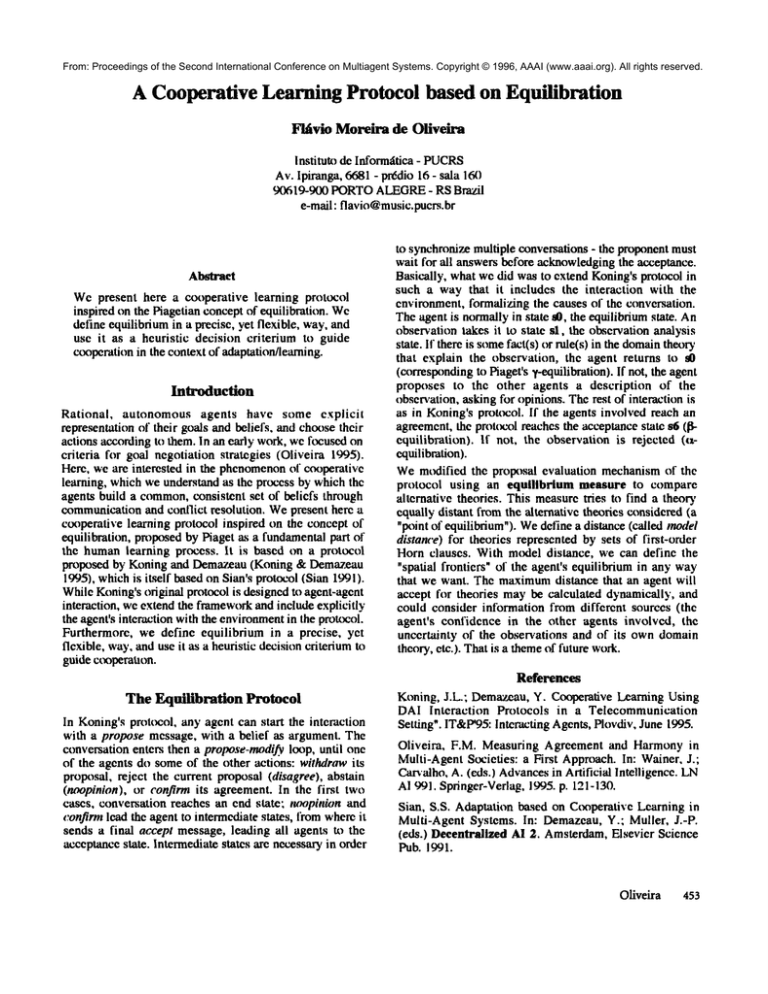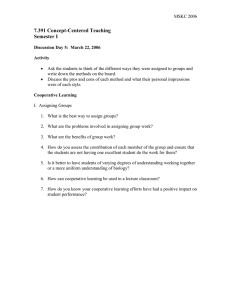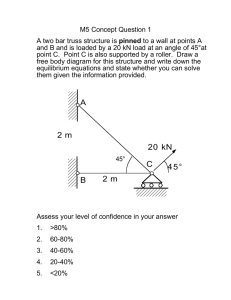
From: Proceedings of the Second International Conference on Multiagent Systems. Copyright © 1996, AAAI (www.aaai.org). All rights reserved.
A Cooperative Learning Protocol based on Equilibration
Fl~vio
Moreira de Olivelra
Instituto de Informdtica - PUCRS
Av. Ipiranga, 6681- pr~dio 16 - sala 160
90619-900 PORTOALEGRE- RS Brazil
e-mail: flavio@music.pucrs.br
Abstract
Wepresent here a cooperative learning protocol
inspired on the Piagetian concept of equilibration. We
define equilibrium in a precise, yet flexible, way, and
usc it as a heuristic decision criterium to guide
cooperationin the context of adaptation/learning.
Introduction
Rational,
autonomous agents have some explicit
represen ’tation of their goals and beliefs, and chcosetheir
actions according to them. In an early work, we focused on
criteria for goal negotiation strategies (Oiiveira 1995).
Here, we are interested in the phenomenonof cooperative
learning, which we understand as the process by which the
agents build a common,consistent set of beliefs through
communicationand conflict resolution. Wepresent here a
cooperative learning protocol inspired on the concept of
equilibration, proposed by Piaget as a fundamentalpart of
the humanlearning process. It is based on a protocol
proposed by Koning and Demazeau (Koning & Demazeau
! 995), whichis itself basedon Sian’s protocol (Sian 199I).
While Koning’soriginal protocol is designcd to agcnt-agent
interaction, wc extend the frameworkand include explicitly
the agent’s interaction with the environmentin the proRx:ol.
Furthermore, we define equilibrium in a precise, yet
flexible, way,and use it as a heuristic decision criterium to
guide cooperatmn.
The F~umbration
Protocol
In Koning’sprotocol, any agcnt can start the interaction
with a propose message, with a belief as argument. The
conversation enters then a propose-modi~loop, until one
of the agents do some of the other actions: withdraw its
proposal, reject the current proposal (disagree), abstain
(noopinion), or confirm its agreement. In the first two
cases, conversation reaches an end state: t~K~pinion and
confirm lead the agent to intermediate states, from whereit
sends a final accept message, leading all agents to the
acceptancestate. Intermediate states are necessary in order
to synchronize multiple conversations - the proponent must
wait for all answers before acknowledgingthe acceptance.
Basically, what wc did was to extend Koning’s protocol in
such a way that it includes the interaction with the
environment, formalizing the causes of the conversation.
The agent is normallyin state sO, the equilibrium state. An
observation rakes it to slate sl, the obscrvation analysis
state. If there is somefact(s) or rule(s) in the domaintheory
that explain the observation, the agent returns to sO
(correspondingto Piaget’s y-equilibration). If not, the agent
proposes to the other agents a description of the
obseta, ation, asking for opinions. The rest of interaction is
as in Koning’s protocol. If the agents involved reach an
agreemcnt, the protocol reaches the acceptance state s6 (~
equilibration). If not, the observation is rejected (txequilibration).
Wemodified the proposal evaluation mechanism of the
protocol using an equilibrium measure to compare
alternative
theories. This measure tries to find a theo
D’
equally distant from the alternative theories considered (a
"tx~int of equilibrium"). Wedefine a distance (called model
distance) for theories represented by sets of first-order
Horn clauses. With m~xlel distance, we can definc the
"spatial frontiers" of the agent’s equilibrium in any way
that we want. The maximumdistance that an agent will
accept fi~r theories maybe calculated dynamically, and
could consider intbrmation from different sources (the
agent’s confidence in the othcr agents involved, the
uncer ’tainty of the observations and of its owndomain
theory, etc.). That is a themeof future work.
References
Koning, J.L., Demazcau,Y. Cooperative L,earning Using
DAI Interaction
Protocols in a Telecommunication
Setting". IT&P’95:Interacting Agents, Piovdiv, June 1995.
Oliveira, F.M. Measuring Agreement and Harmony in
Multi-Agent Societies: a First Approach. In: Wainer, J.;
Carvaiho, A. (eds.) Advancesin Artificial Intelligence.
AI 991. Springer-Verlag, 1995. p. 121-130.
Sian, S.S. Adaptation based on Cooperative Learning in
Multi-Agent Systems. In: Demazcau, Y.; Muller, J.-P.
(eds.) Decentralized AI 2. Amsterdam,Elsevier Scicnce
Pub. 1991.
Oliveira
453






